![]()
![]()
![]()
Use LEFT and RIGHT arrow keys to navigate between flashcards;
Use UP and DOWN arrow keys to flip the card;
H to show hint;
A reads text to speech;
31 Cards in this Set
- Front
- Back
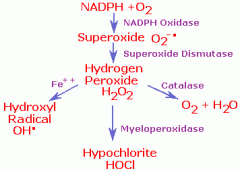
Chronic granulomatous disease
|
-CGD is usually an X-linked disorder caused by deficiency of NADPH oxidase.
-NADPH oxidase deficiency leads to inability of neutrophils to form oxidative burst to kill organisms in their phagolysosomes -Results in negative nitroblue tetrazolium test (patient's neutrophils don't turn blue) -Organisms that produce catalase are not killed by these defective neutrophils -Vs. organisms that do not produce catalase can still be killed due to accumulation of bacterial hydrogen peroxide within the phagosome. |
|
|
Myeloperoxidase
|
-Myeloperoxidase is another neutrophil enzyme that aids in killing phagocytosed organisms by catalyzing production of hypochlorite (bleach) from hydrogen peroxide and chlorine.
-the nitroblue tetrazolium test would cause blue staining within neutrophils (positive test) with meloperoxidase deficiency, because NADPH oxidase is intact in these patients |
|
|
Pyruvate kinase deficiency
|
Common cause of hemolytic anemia
|
|
|
Adenosine deaminase deficiency
|
-Primary cause of SCID
--Autosomal recessive illness that results in a profound deficiency of both B and T lymphocytes. |
|
|
Hepatic metabolism of lipophilic drugs
|
-While kidney is primary site of elimination of most drugs, liver is main site of biotransformation of these agents in preparation for elimination.
-Drugs that are more lipophilic (high volume of distribution (Vd), good penetration into CNS) are preferentially processed by the liver into more polar compounds for easier elimination in the bile and urine. -Liver disease or concomitant use of other drugs may limit (or enhance) clearance of drugs metabolized in liver. |
|
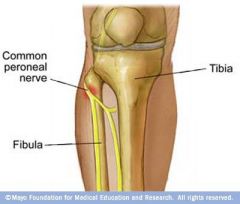
Common peroneal (fibular nerve)
|
-Most commonly injured nerve in the leg due to superficial location where it courses laterally around neck of fibula
--susceptible to trauma due to lateral blow or from plaster cast -Trauma or sustained pressure to fibular head can cause injury to the common peroneal nerve as it courses superficially and laterally to the neck of the fibula |
|
|
Pleiotropy
|
-Pleiotropy is occurrence of multiple phenotypic manifestations (often in different organ systems) as result of a single genetic defect.
-e.g., In classic homocystinuria, cystathionine beta-synthase deficiency --> ectopia lentis (displaced lens), mental retardation, marfanoid habitus, osteoporosis, and vascular problems |
|
|
Polyploidy
|
-Polyploidy occurs when more than two complete sets of homologous chromosomes exist within an organism or cell.
-e.g., in a partial hydatidiform mole (growth in womb during pregnancy), there are cells of nonstandard ploidy (69XXX, or XYY or XXY) --chromosomes in this case are derived from one haploid maternal set and two haploid paternal sets of chromosomes -Most syndromic genetic illnesses exhibit pleiotropy |
|
|
Genetic linkage
|
-Genetic linkage describes alleles that tend to be inherited jointly, usually because they are located near each other on the same strand of DNA
|
|
|
Penetrance
|
-refers to proportion of individuals with a given genotype that express the associated phenotype
-incomplete penetrance: less than 100% of individuals with a given genotype express the associated phenotype |
|
|
Segregation
|
-Law of segregation = Mendel's first law
-Describes phenomenon whereby gametogenesis within parent organism results in separation of paired chromosomes, and thus separation of paired genes so that EACH OFFSPRING INHERITS ONLY HALF OF EACH PARENT'S GENETIC COMPOSITION. |
|
|
Imprinting
|
Parental imprinting refers to preferential transcription of genes from one or another of a homologous pair of chromosomes
--depends on parental origin of the chromosome. |
|
|
ACE inhibitors
-"pril" -Captopril, enalapril, lisinopril |
-inhibit ACE -->
-decreased angiotensin II --> -decreased GFR by preventing constriction of efferent arterioles -renin level increases due to loss of feedback inhibition -Inhibition of ACE also prevents inactivation of bradykinin, a potent vasodilator. -Angiotensin II receptors blockers (-sartans) have similar effects, but don't increase bradykinin -So decreased risk of cough or angioedema |
|
|
Clinical use of ACE inhibitors
|
-Hypertension
-CHF -proteinuria -diabetic nephropathy -prevent unfavorable heart remodeling that results from chronic hypertension --chronic angiotensin II mediated left ventricular hypertrophy/remodeling associated with heart failure -In patients with HTN and chronic ischemic myocardial failure, ACE inhibitors considered to be most effective long-term treatment option. (Beta-blocker would also be beneficial) |
|
|
ACE inhibitor toxicity
"CATCHH" |
-Cough
-Angioedema (contraindicated in GI esterase inhibitor deficiency, which causes edema) -Teratogen (fetal renal malformations) -Hyperkalemia -Hypotension. -Avoid ACE inhibitors in bilateral renal artery stenosis, because ACE inhibitors will further decrease the GFR, precipitating renal failure |
|
|
Hydrochlorothiazide
|
A thiazide diuretic is one of the initial treatments recommended for essential hypertension in a patient WITHOUT CHF or diabetes.
-Could be used for short-term symptomatic relief of CHF and pulmonary edema, but an ACE inhibitor would be used long-term in this case. |
|
|
Transposition of the great arteries/vessels
|
-an echocardiogram that shows aorta lying anterior and to right of pulmonary artery is diagnostic of transposition of the great arteries.
-TGA results from failure of fetal aorticopulmonary septum to spiral normally during septation of the truncus arteriosus, producing life-threatening cyanosis at birth. -Patient can present with machine-like murmur (due to patent ductus arteriosus), or systolic-only murmur, or no murmur, depending on location and size of atrioventricular septal defects. |
|
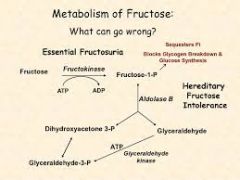
Aldolase B deficiency
|
-Aldolase B deficiency causes hereditary fructose intolerance.
-disease manifests after introduction of fructose to diet with vomiting and hypoglycemia ~20 minutes after fructose ingestion. -affected infant presents with failure to thrive, jaundice, and hepatomegaly |
|
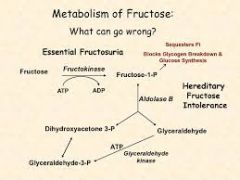
-Fructokinase deficiency
|
-causes essential fructosuria (benign AR disorder)
-fructose from diet is absorbed and secreted freely in urine due to impaired first step of fructose metabolism |
|
|
MDR1 gene
-tumor cell resistance |
The human multi drug resistance (MDR1) gene codes for P-glycoprotein, a transmembrane ATP-dependent efflux pump protein found on HUMAN TUMOR CELLS that has broad specificity for hydrophobic compounds
-This protein can both reduce influx of drugs into cytosol and increase efflux from cytosol, thereby preventing action of chemotherapeutic agents. -In tumor cells, this protein actively removes chemotherapeutic agents, particularly hydrophobic agents like the anthracyclines. -P-glycoprotein is normally expressed in intestinal and renal tubular epithelial cells – functions to eliminate foreign compounds from body. -also present in capillary endothelium of vessels that for the blood-brain barrier (prevents foreign compounds from entering CNS) |
|
|
Thyroid peroxidase
|
-catalyzes iodide oxidation; formation of mono- and di-iodotyrosin, and the coupling that forms T3 and T4
i.e., function of thyroid peroxidase is to cause thyroglobulin iodination |
|
|
mRNA codons
|
-There is one codon that signals initiation of protein synthesis: AUG
-Three codons stop protein synthesis (UAA, UAG, UGA) – Universities of Georgia, Alabama-Gramingham, and Alcoholics anonymous -Transfer RNA molecules (tRNA) transport amino acids to site of protein synthesis and ensure placement of proper amino acid for a given mRNA codon. -Each tRNA contains a specific anti-codon that is complementary (oriented in anti-parallel direction) to certain mRNA codons. -for example, if mRNA codon is 5'-UUG-3', then corresponding tRNA anticodon is 5'-CAA-3' |
|
|
GLUT 4 glucose transporter
|
-The main cell types that express GLUT 4 glucose transporter are adipocytes and skeletal muscle cells
-so their glucose uptake is insulin mediated |
|
|
-Glucose transporter types
|
GLUT 1 – RBCs, CNS – basal glucose transport
GLUT-2 – hepatocytes, pancreatic beta-cells – regulate insulin release GLUT-3 – placenta, brain, kidney – placental glucose transport GLUT-4 – muscle cells, adipocytes – insulin-mediated glucose uptake GLUT-5 – spermatocytes, GI tract – fructose transport |
|
|
Causative agents of UTIs in women
|
-E. coli is the most common pathogen that causes cystitis and acute pyelonephritis
-2nd most common cause of UTI in sexually active women is Staphylococcus saprophyticus -UTIs more often affect women due to short urethra -vs. recurrent UTIs in boys or men require investigation for urinary tract obstruction or reflux |
|
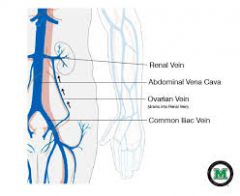
Left renal vein blockage
|
-The left gonadal (testicular or ovarian) vein drains into left renal vein
-Obstruction commonly leads to left-sided varicoceles in males -vs. right gonadal vein drains RIGHT into the inferior vena cava. |
|
|
Mechanisms of bacterial gene transfer
-Transformation |
-Transformation = direct uptake of naked DNA from environment by bacteria that are naturally competent:
--Strep pneumonia, H. influenza, Neisseria "SHh, be nice" and take up the naked DNA --non-capsule-formin strains of S pneumonia can acquire the genes that code for a certain feature (e.g., a virulent capsule) |
|
|
-Conjugation
|
-Conjugation is a one-way transfer of DNA between bacterial cells, via direct physical contact
-"conjugal visit sex" -Donor cells contain an extra segment of DNA called F factor that codes for a sex pills and other proteins needed to transfer DNA to F- recipients |
|
|
-Transduction
-generalized vs. specialized transduction |
-Transduction is transfer of DNA by a bacteriophage
-"transduction virus" -generalized transduction occurs during lytic infection, when random bacterial genes are accidentally packaged into the viral capsid -specialized transduction occurs in lysogenic infection, when select bacterial genes near the viral insertion site are excised and packaged into the vision |
|
|
Bis-phosphates (pharm)
|
Bis-phosphates are structural analogues of pyrophosphate, an important component of hydroxyapatite.
-These drugs are used in treatment of osteoporosis, Paget's disease of the bone, and malignancy-induced hypercalcemia -administered in fasting state with plenty of water -patient must also stay upright for at least 30 minutes to prevent reflux esophagitis |
|
|
Positive predictive value
|
-lowering the cut-off point of a test will increase sensitivity of the test
-the true positives will also increase, but the false positives will have a relatively larger increase. -this results in a decrease in the positive predictive value (PPV) and the false negatives (FN) |

